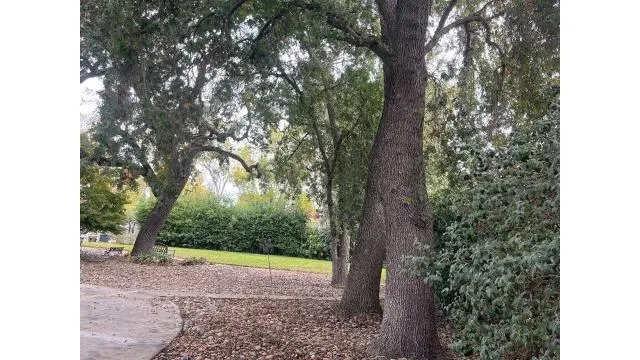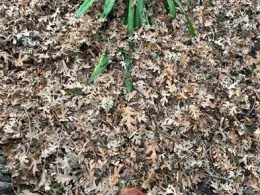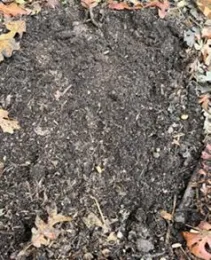When we lived in St. Louis Missouri, pin oaks graced the yards of our neighborhoods. When they dropped their leaves in the fall, the raking began with families filling up paper sacks purchased in bulk from the box stores. The annual fall event was as important as Halloween. The more rows of sacks on the curb, the more efficient and conscientious you were about raking leaves. I was so thankful burning was not allowed.
However, I never filled any paper sacks ever. I thought it a waste of time and energy. Instead, I first waited for the leaves in my yard to be windblown around the neighborhood. “Who can control the wind?” I thought. What a great idea this was. Some of my neighbors must have had the same idea and their leaves would end up equally in my yard. After seeing all of the leaves had fallen and been blown or raked, I would run my lawnmower with a mulching blade, cutting the grass and disintegrating the leaves. With the first fall rains, the leaves disappeared and my lawn and oak trees looked great in the spring.
We encountered a much different situation when we moved back to California in 2016. We now have a fenced, partially xeriscape backyard, with islands of mature valley oaks surrounded by a sea of river rocks. There was
an adjacent lawn area separated by a sidewalk where the late fall and winter oak leaves could be blown or raked for mowing or collection. However, there were too many leaves and not enough lawn to absorb the mutinous gathering. Where was my “aha” moment now?

Collaborating with Master Gardeners and reviewing university studies on leaf mulching / compositing, my first “aha” moment arrived. The answers to whether you should mulch oak leaves into turf, compost the leaves, use leaves for landscape mulch, till leaves into your vegetable garden, simply let the leaf litter lie, or combinations thereof, were summed up in two words: “it depends.” For my situation, it made sense to mulch some leaves into the turf, collect some for landscape mulch, till some into the vegetable garden, and compost the remainder. I was happy to have choices.
Mother Nature has been recycling oak leaves back into soil nutrients for plant growth since the first oak tree. There are numerous University studies that help us to better understand this process. Soil organisms (bacteria, fungi, worms, and insects) utilize oak leaves as a food source and in particular, release nitrogen, phosphorous, and sulfur back into the soil. By design, the rate of leaf litter decomposition and release of nutrients back into the soil is relatively slow. This is partially due to the low nitrogen content of leaves which controls the rate of decomposition. If you are using shredded leaves for landscape mulch, this is a good thing, as you want mulch to remain in place to prevent weeds from germinating / growing, hold in moisture, and slowly release nutrients back into the soil. However, if you are mulching leaves into turf, tilling into the vegetable garden soil or composting, an accelerated rate of decomposition may be more desirable.

To increase decomposition rates, decomposers require more nitrogen, around 30:1, which translates into one pound of nitrogen to thirty pounds of lightly moist organic material. The 30:1 ratio is achieved by blending oak leaves with high nitrogen sources such as inorganic fertilizer, grass clippings, and manures. Additional environmental factors that will speed up decomposition rates include adequate aeration, moisture, particle size, and heat. The Soil and Fertilizer Management Chapter of the California Master Gardener Handbook, Second Edition, as well as The University of Missouri Extension “Making and Using Compost” provides information on how to optimize decomposition rates, C:N ratios of compostable organic and inorganic materials, how to set up a compost pile and trouble shooting.

When tilling oak leaf litter (low in nitrogen) into soil as an amendment, the decomposer population and activities increase. However, Instead of adding nitrogen to the soil, they incorporate the nitrogen into their own cellular tissues. In this process called “Immobilization”, microbes are competing with plants for nitrogen. Therefore, if incorporating leaf litter into the soil at time of planting, it is recommended to add inorganic nitrogen fertilizer to balance the C:N ratio to around 30:1. Immobilization only temporarily locks up nitrogen and when the microorganisms die after consuming their food source, the nitrogen contained in their cells is converted back to plant available nitrogen.
For More Information
ANRCatalog - California Master Gardener Handbook--2nd Ed - ANR Catalog (ucanr.edu)
Making and Using Compost, G6956 | MU Extension (missouri.edu)
Don't Bag It - Leaf Management Plan - Earth-Kind® Landscaping Earth-Kind® Landscaping (tamu.edu)
Mulch leaves into turf for a smart lawn - Gardening in Michigan (msu.edu)
Don't sweep your leaves to the curb! Mulch them back into your lawn or garden - MSU Extension
https://www.youtube.com/watch?v=os-EFAPLcP0
Recycling Autumn Leaves // Missouri Environment and Garden News Article // Integrated Pest Management, University of Missouri
Autumn Leaves: From Trash to Treasure // Missouri Environment and Garden News Article // Integrated Pest Management, University of Missouri
Autumn Leaves - Myth and Reality | Missouri Department of Conservation (mo.gov)

